INSIDERS’ VIEW ON TRADITIONAL PORTUGUESE SOUPS
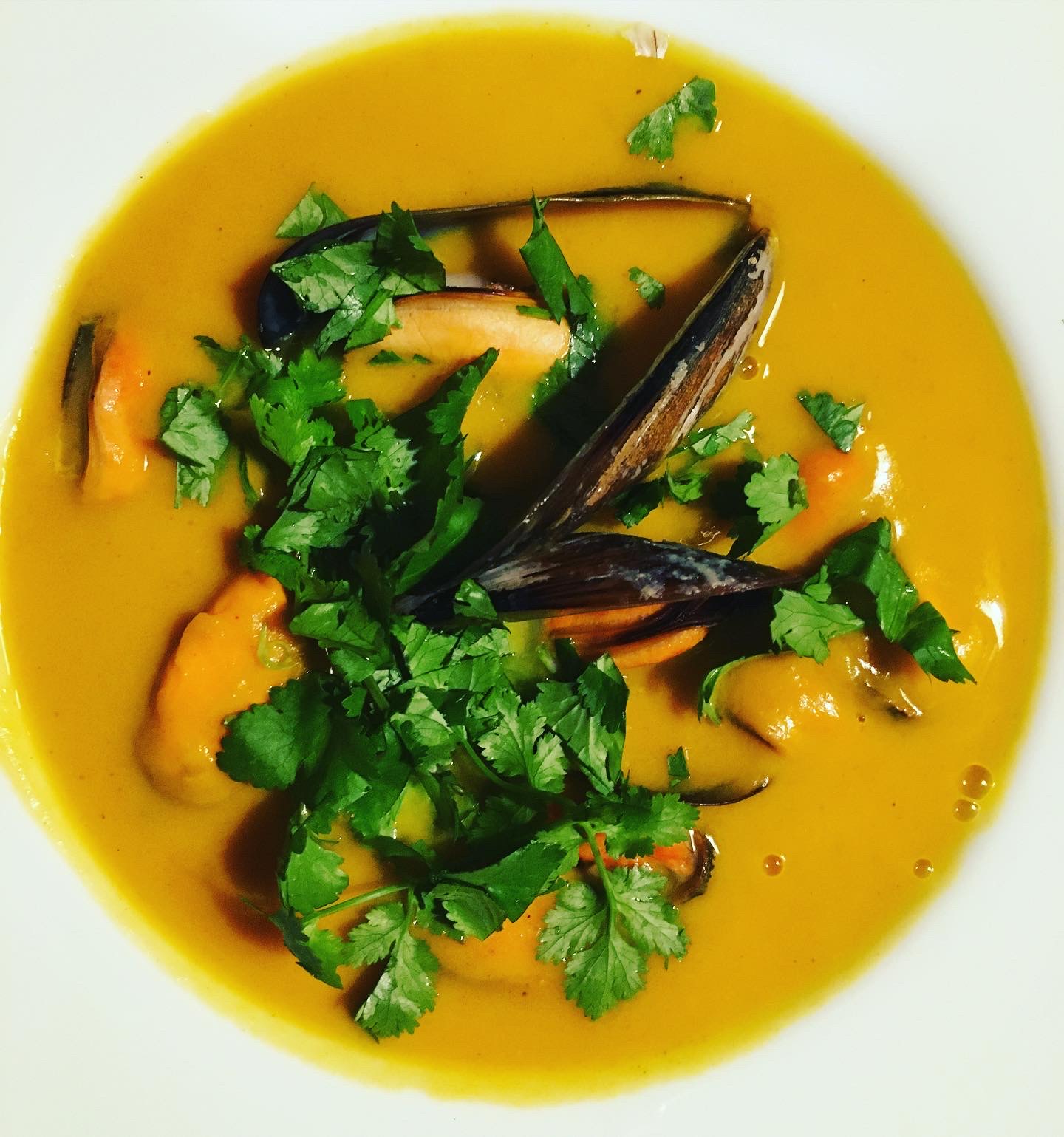
Soups, a staple of the Portuguese eating habits, can be classed as one of the most inexpensive yet versatile foods to cook. The variety of Portuguese soups is endless. From hearty, warming stews to light and refreshing broths that are perfect on a hot summer day, soups are eclectic and there’s always a recipe for everyone. Between hearty kale soup, chicken soup, and gaspacho there’s no shortage of tasty options. Portuguese soup recipes included!
Does soup still play a role in Portuguese eating habits?
In Portugal, soup season is all year. Hot soup is an essential part of Portuguese diet.
Until recently, tradition dictates that soup was often served as a starter before lunch or dinner. This was considered healthy and a balanced meal but for many Portuguese kids, this could also feel like torture!
But soup can also make an excellent main dish, both savory and filling. It’s a great option for those on a budget, particularly when temperatures drop during winter.
In any Portuguese restaurant or tasca you will always see at least one soup on the menu, barely costing more than a euro makes it one of the cheapest dishes you can find in Lisbon.

Homemade coconut Thai soup
Sure, during the last 20 years we have seen a change in the traditional dietary habits: new ingredients, new techniques, new trends, new influences.
Portuguese locals still eat soup frequently but, probably not as much as before, but this is because we love the influx of other types of cuisines, from different corners of the world – especially in our cities -, and we love to taste diversity!
For instance, if you are having a sushi dinner (or “having sushi for dinner”), you will not order a Portuguese soup! The same applies to a Mexican lunch, or a Peruvian dinner. But, on the other hand, it’s amazing to see how the younger generations are embracing other types of soups, like ramens and wonton soups, that you can easily find in areas like Martim Moniz (in Lisbon).
So, if you think about soup in a more in-depth way, you will notice that it’s still a frequent dish in Portuguese diet. And how couldn’t that be?
The undeniable power of soups
Soup is one of the most important and essential elements in the gastronomic world and transversal to all cultures.
A primarily liquid food, soups are made by combining meat, vegetables, and fish with stock or water.
Japanese food culture, which can be found in UNESCO’s Intangible Cultural Heritage list, is said to be based on the ‘one soup, three vegetables’ principle, providing the ideal balance of nutrients.
In Portugal, in poor households, soup was often the main dish: balanced, rich in nutrients and easy to do with whatever ingredients were had on hand. The example of açorda, a soup from Alentejo, shows what people can create with scarce ingredients like old bread, garlic, coriander and olive oil. Sometimes an egg, a piece of sheep’s cheese, or in more abundant times, a piece of codfish can be a welcomed addition. For me, açorda is one of the most emblematic and delicious soups in Portugal.
Other soups, like Canja de Galinha (Chicken soup), are believed to be especially effective to overcome colds, digestive problems, and other mild forms of sickness.
The variety of Portuguese soups ranges from hearty, warming stews to light and refreshing broths that are perfect on a hot summer day. Portuguese soups have been deemed “tasty”, “nourishing” and “pleasurable”. There is something for everyone – it doesn’t matter if you’re looking for an inexpensive meal or simply want a comforting dish after a long day at work.
Follow me through this Portugal soup journey, perfect to warm up your hearts and hands on chilly days – and yes, I added a cold soup also, for those who are reading us from a summer latitude and because spring is coming to Portugal!
We will always use the Portuguese and the English title for each soup. In case you do not speak Portuguese, this will help you to overcome questions like how to say fish soup in Portuguese ?
Portugal soup journey
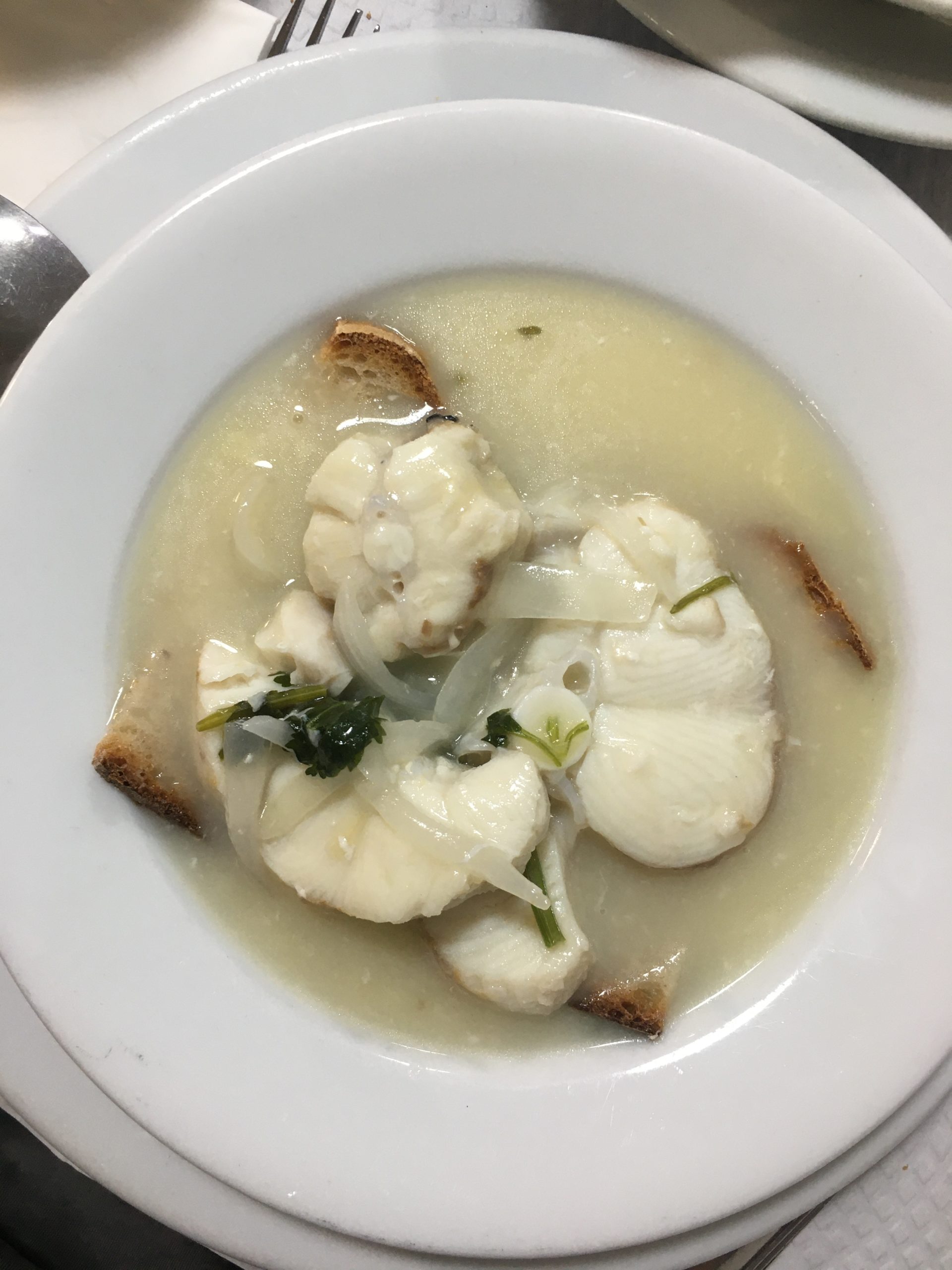
Dogfish soup at a restaurant in Mértola
Sopa de Cação (Alentejo Region) | Dogfish Soup
Portugal has a long list of fish recipes but “sopa de cação” it’s quite unique. It’s believed that this recipe emerged from the fact that dogfish was never really a type of fish that brought much value to fishermen. Whenever it was caught up in fishing nets, it was soon dispatched to one of the poorest areas in Portugal: the Alentejo region (a large region south of Lisbon). But today it is considered to be an indispensable part of Portuguese cuisine. And as most of the Alentejo’s gastronomy, this is a delicious, creative and unique dish!
The dogfish shark is cooked in a flavorful broth infused with garlic and coriander. The dish is traditionally served over sliced bread, and it is occasionally thickened with flour and seasoned with bay leaves, ground paprika, and vinegar.
This one was ordered and tasted in Mértola village, one of my favourite places in the interior of Alentejo region (contrasting with the Atlantic Alentejo coast).
Sopa de Caldo Verde (Minho region) | Portuguese Kale soup
Caldo verde or Portuguese Kale soup, is probably the most popular soup from Portugal, it’ mostly consumed by Portuguese families at home, but it is also served in some upper-class restaurants.
This Portuguese soup cabbage originated in Minho province during the 20th century and is now one of the most cherished dishes of Portugal. This comfort food was considered in 2011 one of the seven wonders of Portuguese gastronomy.
It can be served as a starter before the main meal, ideally accompanied by broa, a traditional Portuguese cornbread.
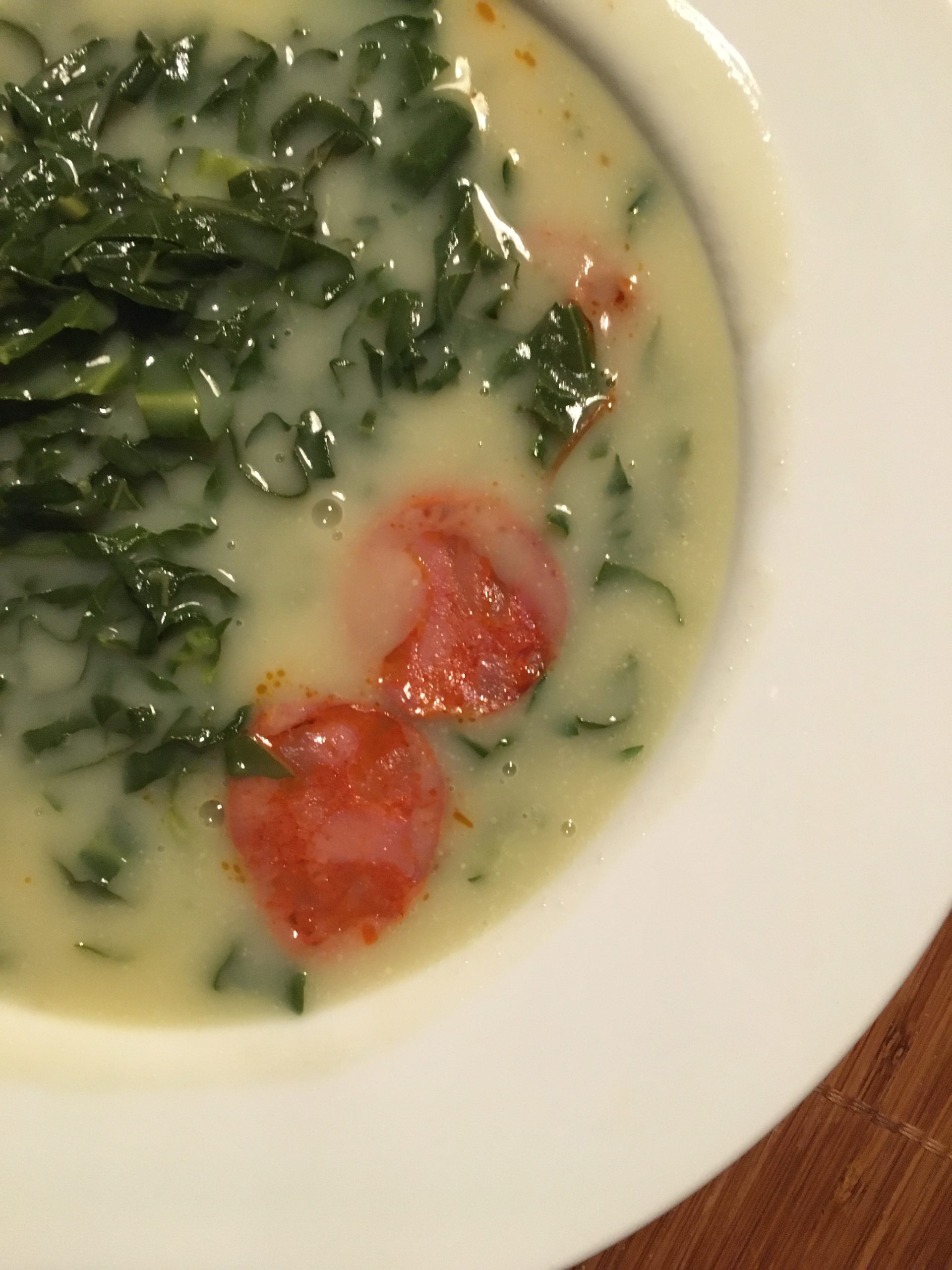
Homemade Portuguese kale soup
In Lisbon (but not only!), it’s also a great option for hangover food eaten in late night restaurants, after dancing all night. In this case, instead of the cornbread, you would be served with a hot bread of chouriço fresh out of a wood oven. Yes, I know, you are already feeling like partying as well just to have a Caldo Verde after!
Tradition also says that this Portuguese green soup (literal translation) is the best companion for an evening of listening to Fado music.
So, indeed, a bohemian soup!
It’s made with potato, onion, and garlic puree, shredded Portuguese kale (in this case from my aunty) and olive oil. When serving we add a slice – or two, or three! – of chorizo.
If you are vegan/vegetarian, make sure to ask without chorizo and you’re perfectly good to go if it is not used in the cooking process itself (i cook with it, because it adds flavour to the cream).
Check here to have my Portuguese kale soup recipe.
Açorda de Bacalhau (Alentejo Region) | Codfish Bread Soup
The word açorda, has Arabic roots, as do many Portuguese words. Etymologically, it is derived from the Arabic dialectal word al-thurda used in the empire Al-Andalus, when the Muslim-ruled The Iberian Peninsula.
Al-thurda, which is the closest link to the Portuguese word açorda, meant sliced soaked bread and it seems it was a subsistence dish during alimentary crises
In fact, in the Alentejo region – where this Portuguese bread soup is presently best represented – açorda or sopa Alentejana took root as a means of using Alentejano’s stale bread.
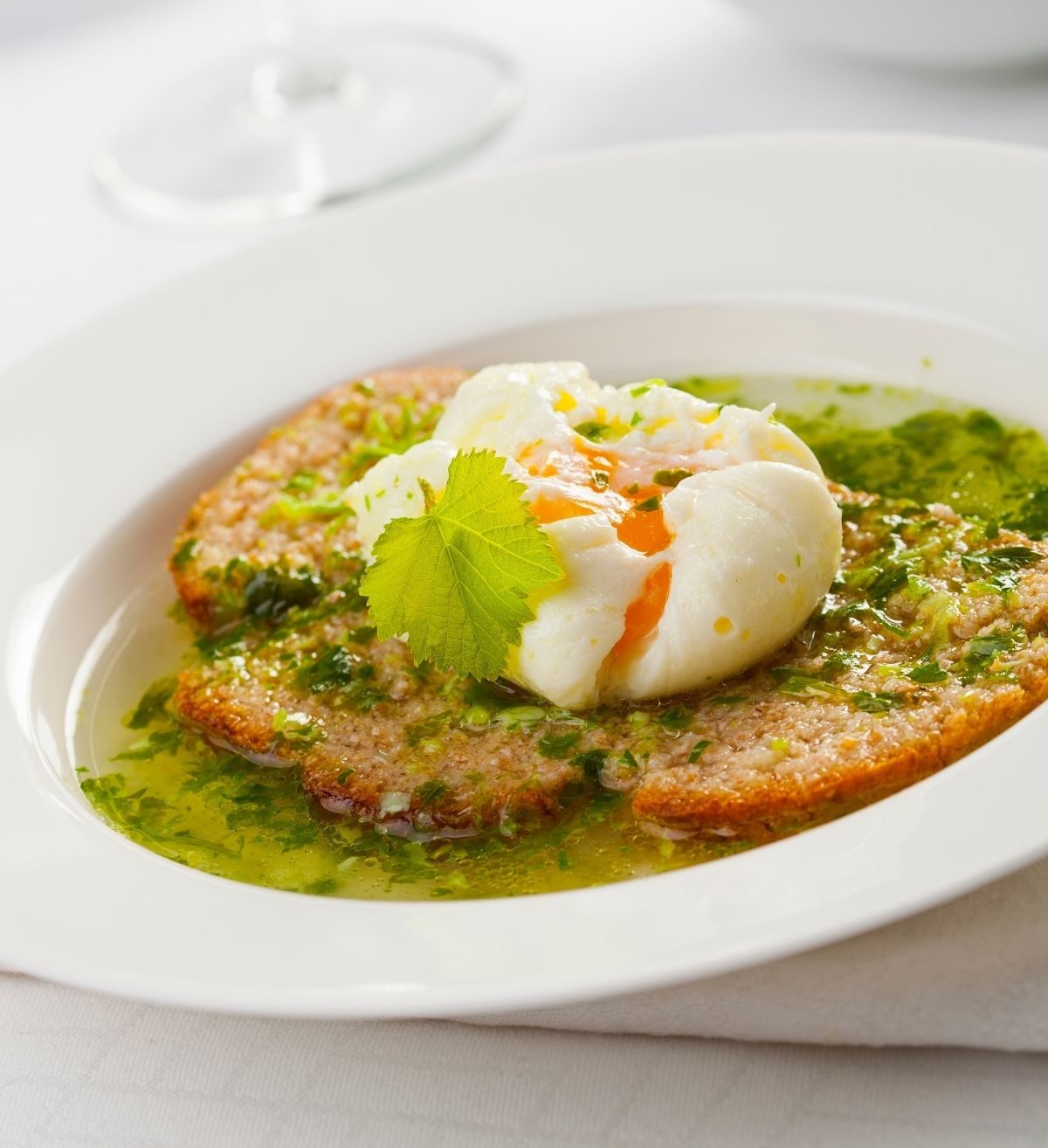
Açorda alentejana with poached eggs
Bread is one of the cornerstones of the Southern European diet, and Portugal, with all its rich and diverse bread making history, is no exception. More than just a vehicle to fillings, bread served as a pivotal energy source for countless generations. The respect for bread was unquestionable, so it was only convenient to avoid wasting it, at all costs. Thus, far and wide throughout the country, old and stale bread was included in a myriad of repurposing recipes, from savory to sweet. The use of bread in soups and migas was presumably the most common.
You can have several variations of it, depending on the ingredients you have on hand (for economical reasons or just by choice). You can have vegan variations (with only garlic, bread, coriander and olive oil), vegetarian variations (to which you can add eggs or fresh cheese) or the ones which include codfish, for example.
Basically, this soup consists of slices of stale bread that are drizzled with olive oil and then soaked in boiling water infused with garlic, salt, and coriander (or cilantro). Poached eggs can be placed on top of the bread just before serving.
In this codfish açorda variation the cod is either left whole or mashed with bread.
Canja de Galinha | Chicken soup
Canja de Galinha is basically a hearty chicken broth upgraded with onions, garlic, mint leaves and, depending on the region, rice or short cut pasta. Occasionally it can have diced root vegetables such as celery and carrots.
Canja de galinha is commonly eaten throughout the year, but it’s also associated with special circumstances. In Portugal but also in Cape Verde and Brazil (former Portuguese colonies), canja de galinha is widely believed to help a person overcome colds, digestion issues, and other soft forms of sickness.
In Cape Verde, canja is sometimes eaten after a funeral, but also on more festive occasions such as New Year’s Eve, marriages and other equivalent events.
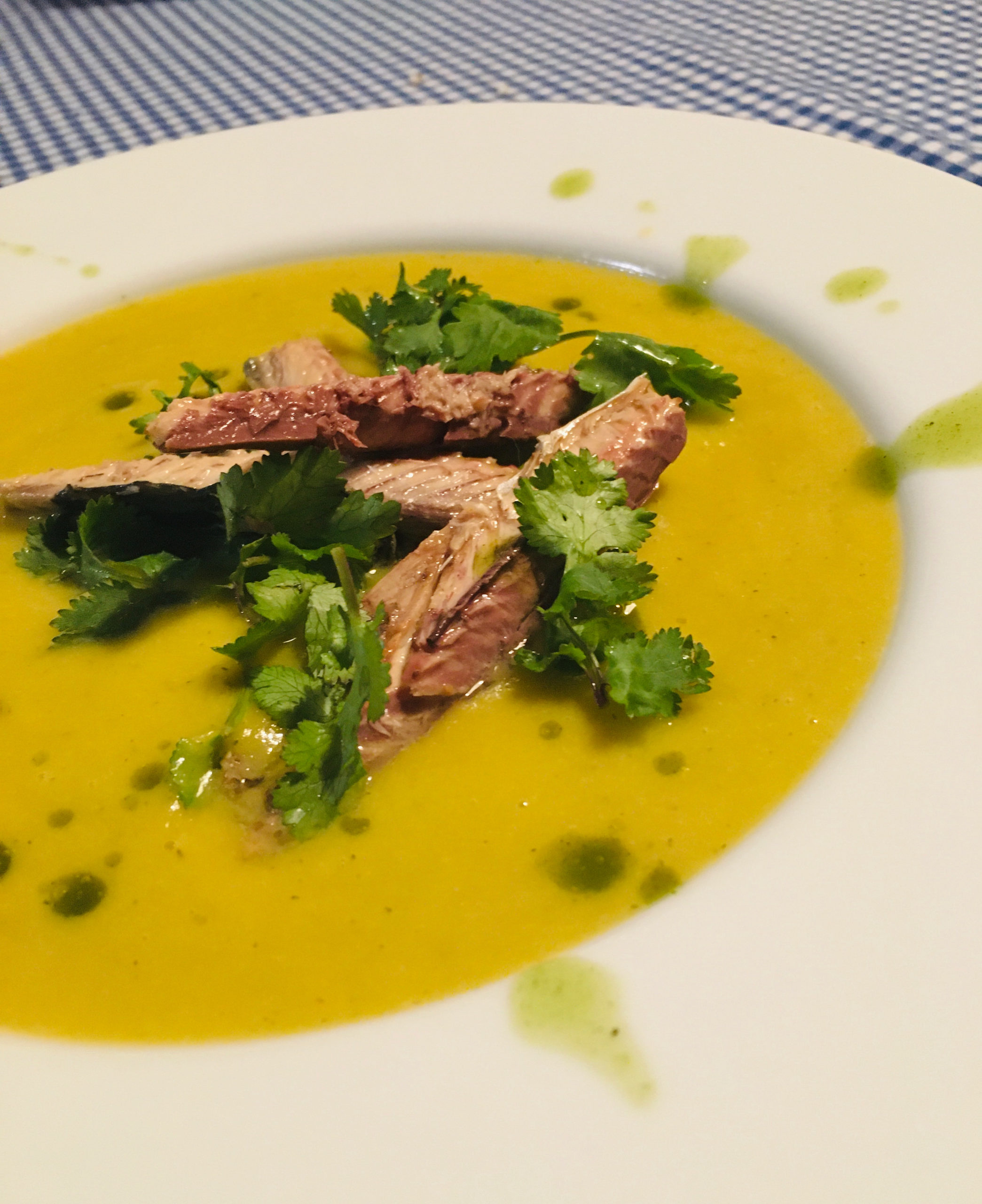
Homemade common vegetable soup with canned mackerel
For sure, canja is one of the most comforting soups.
Creme de vegetais | Cream of Vegetable
Nutritious, economic, easy to prepare and smooth in your mouth. Great for all occasions and people: babies, kids and adults, everyday meals or fancier occasions.
The base can include whatever vegetable you like. Portuguese cream of vegetable soup frequently includes potato, carrot or pumpkin, since they are very common ingredients in Portugal. Some varieties of Cream of vegetable soup are what we find as “soup of the day” in many restaurants.
If you want to had some texture to the cream add some extra ingredients at your preference, like canned fish or cooked mushrooms and season with some herbs. In the picture aside I made a cream with vegetables I found in my fridge: pumpking, leek, parsnip. Then i added some delicious canned mackerel fileets in olive oil and jalapeño mexican chilli.
I personally like to use leek and/or red bell pepper, to intensify the taste, or/and parsnip to smooth the texture. Some seasoning, like curry powder, can change everything.
On the topic of cream of vegetable soups, here is a soup I recently discovered, which combines products you can find easily in Portugal – pumpkin and mussels – with some curry spices, an influence from Portugal’s former colonies and the Bangladeshi communities living in Lisbon.
The combination of spices, squash and mussels brings a special experience, and even without the mussels this soup is very good. You can use any squash, though you may want to tweak the seasoning if you opt for one that’s much sweeter than butternut squash. The soup can be made a day ahead, leaving just the mussels to cook and add just before serving.
Easy to do, inexpensive, this soup is a show stopper. It’s perfect for a special occasion, a summer cookout or just an evening at home with the family.
Serves 4
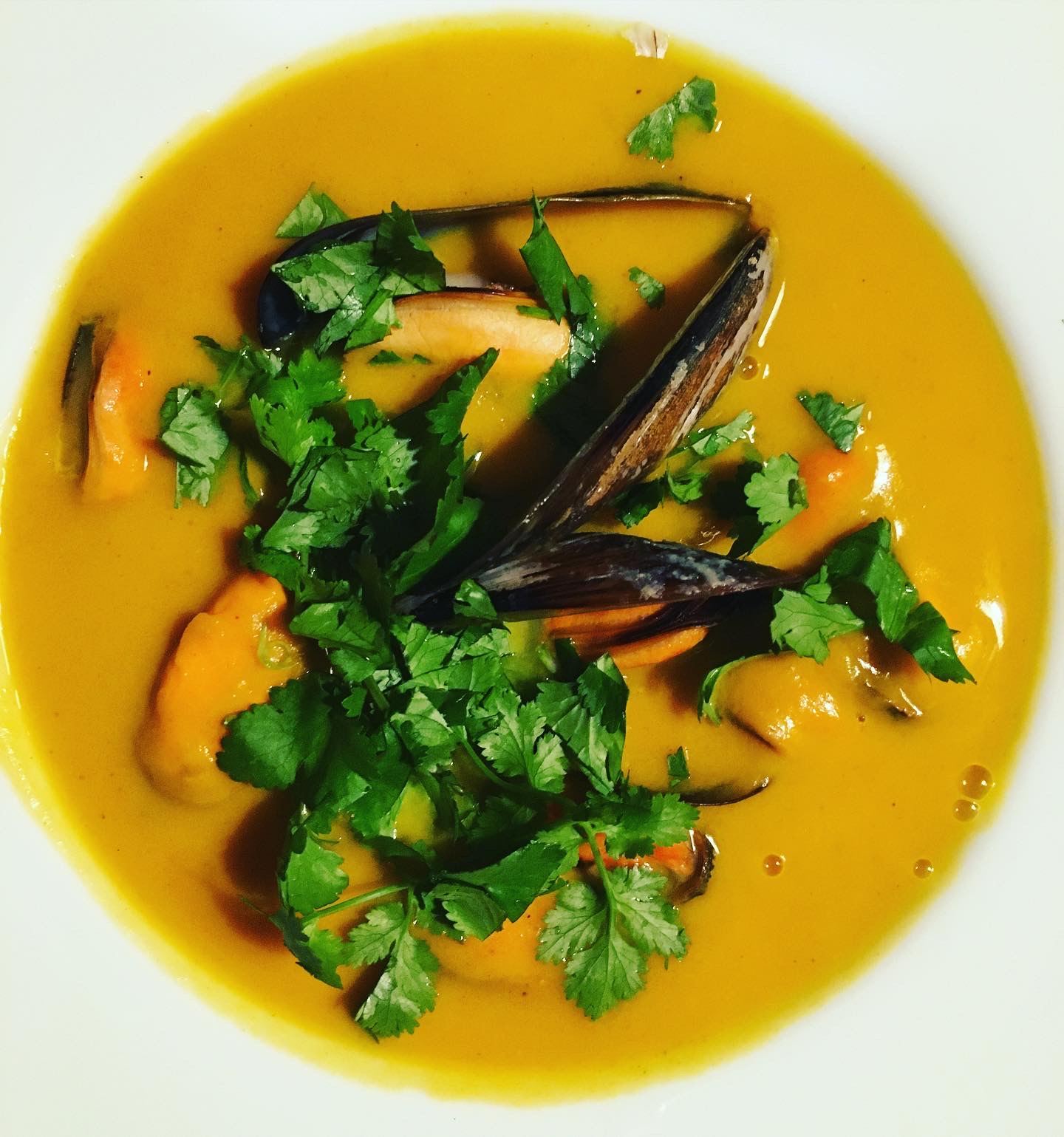
Homemade pumpkin curry soup with mussels
1Kg squash/pumpkin
Olive oil
1 onion
1 leek finely chopped
1tsp ground cumin
1tsp ground coriander
1tsp ground turmeric
1tsp chili powder cumin
1tsp garam masala
600ml chicken or vegetable stock
350ml white wine
A small handful of thyme (or coriander)
800g mussels cleaned
Sea salt and freshly ground black pepper
Method:
Peel, deseed and coarsely grate the squash.
Cook the shallots and leek gently, stirring frequently, until softened in olive oil. Stir in the spices and cook for a couple of minutes. Add the squash, then pour in the stock and stir well. Cover and simmer gently for 25 minutes.
Allow the soup to cool just a little, then purée in a blender until smooth. Return to the pan and keep hot over a low heat.
Heat the wine with the thyme in another large pan (that has a tight-fitting lid) and bring to a simmer. Add the mussels and season well with salt and pepper. Put the lid on, turn up the heat a little and steam the mussels for 4-5 minutes, shaking the pan every minute or so. Meanwhile, chop most of the coriander. Remove all but four of the mussels from their shells.
Add the chopped coriander to the soup, taste and season if necessary. Share the shelled mussels between warmed deep bowls. Ladle the soup over the mussels and scatter over the remaining coriander. Add a mussel in the shell to each bowl and serve.
You can find this and other seasonal recipes on this beautiful and inspiring book from Marco Diacono.
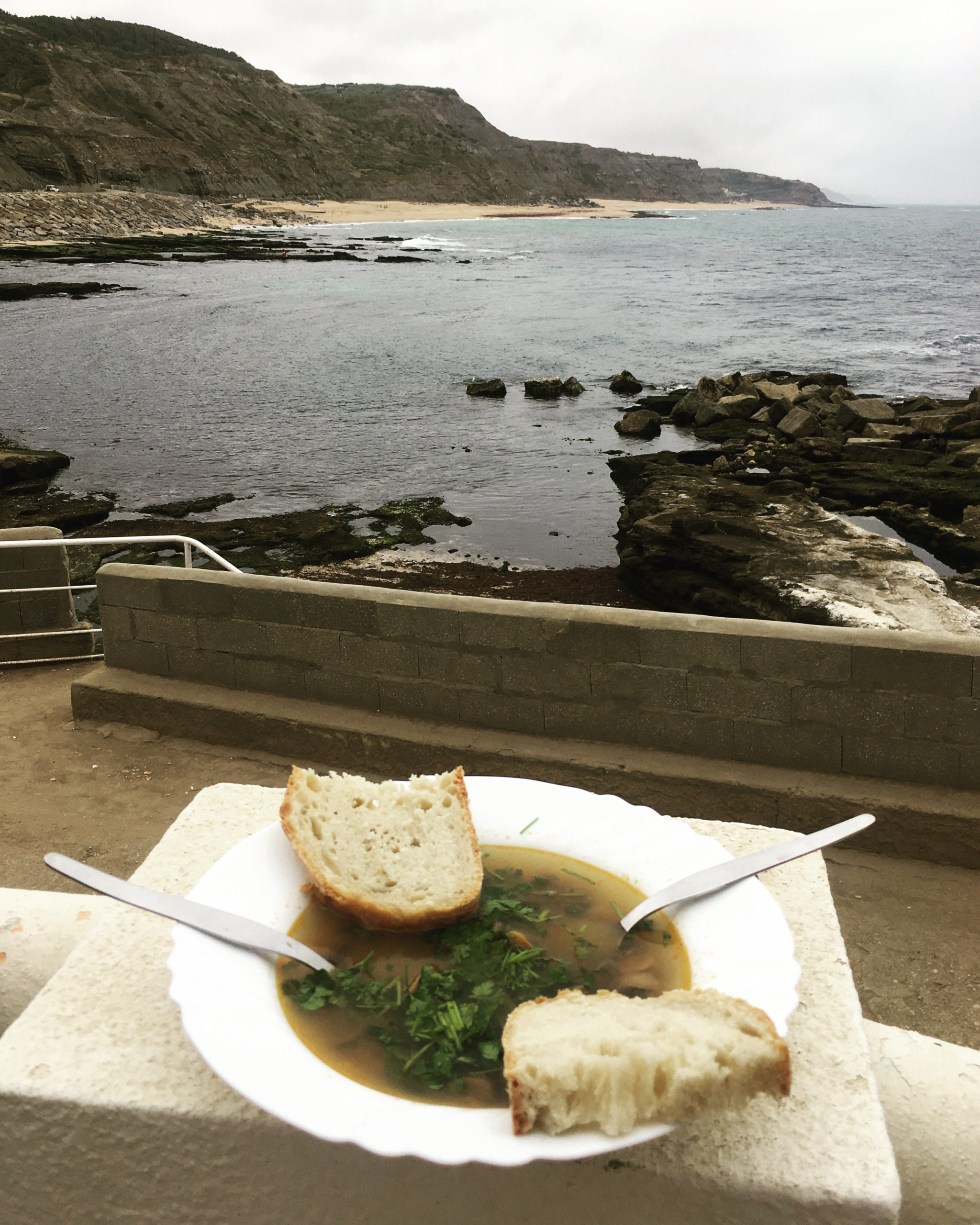
Limpets soup offered by Portuguese fishermen
Sopa de Peixe | Fish Soup
One of the finest and yet most popular eats is the sopa de peixe, or fish soup. The extensive Portuguese coastline and fresh fish is what makes it one of the most popular soups in Portuguese gastronomy. Wherever you are in Portugal, there is almost always a regional fish soup for you. A dish that embodies the Atlantic Diet and the Atlantic gastronomical heritage.
It’s made of some fishy bits and pieces that are immersed and cooked in a delicious tomato stock with garlic, onion, olive oil and herbs. It can be done using a mix and match of different types of fish or a single type of fish, in which the main bite can be anything from monkfish to white fish. Finally, topping off the dish, a generous sprinkle of coriander adds that final touch.
If you belong to that margin of the population that hates cilantro, parsley would be a great substitute!
This is a perfect soup to pair with a sunset in Lisbon in front of the river!
Gaspacho à Alentejana e Arjamolho (Algarve) | Gazpacho Alentejano and Arjamolho
Gaspacho à alentejana, is a cold Portuguese soup, popular during the summer months. It consists of simple raw ingredients, which are blended together.
Presently, there are, several modern variations but, essentially gazpacho à Alentejana (typically from Alentejo, southern Portuguese region) is made up of bread, tomatoes, peppers, onions, cucumbers, and garlic that are diced into small pieces, and olive oil. In addition to the fresh vegetables used for this dish, gazpacho also contains vinegar and sugar which provide acidity and sweetness respectively, some spices which add just the right amount of tangy flavor! In order to prepare the soup properly, it must be chilled in a refrigerator overnight so that all of the ingredients can marinate together.
In the Algarve we will find arjamolho, similar to gaspacho, but with different proportions of ingredients.
This soup doesn’t have any meat or seafood but this sweet and spicy icy-cold soup is for many a favorite on hot days!
Gazpacho was initially popularized in the Andalusian area of Spain long ago – during the Roman empire – with slightly different ingredients (remember that tomatoes only arrived in Europe in the 16th century, when the Spanish first brought them from South America) and then extended to the south of Portugal. The major difference between the Gaspacho à Alentejana and the Spanish version is that the ingredients are in chunks instead of creamy and blended.
My version of gazpacho includes watermelon (complementing the tomato) and basil and uses a combination of textures (some vegetables are blended while others are in chunks). Besides, I love watermelon and by adding this fruit we enhance sweetness. But, this tweak is perfect for people who have a sensitive stomach, since it reduces the acidity from the tomato. Lighter than other recipes but still full of the vitamins and nutrients your body needs on a hot day.
My gazpacho soup recipe:
Serves 6
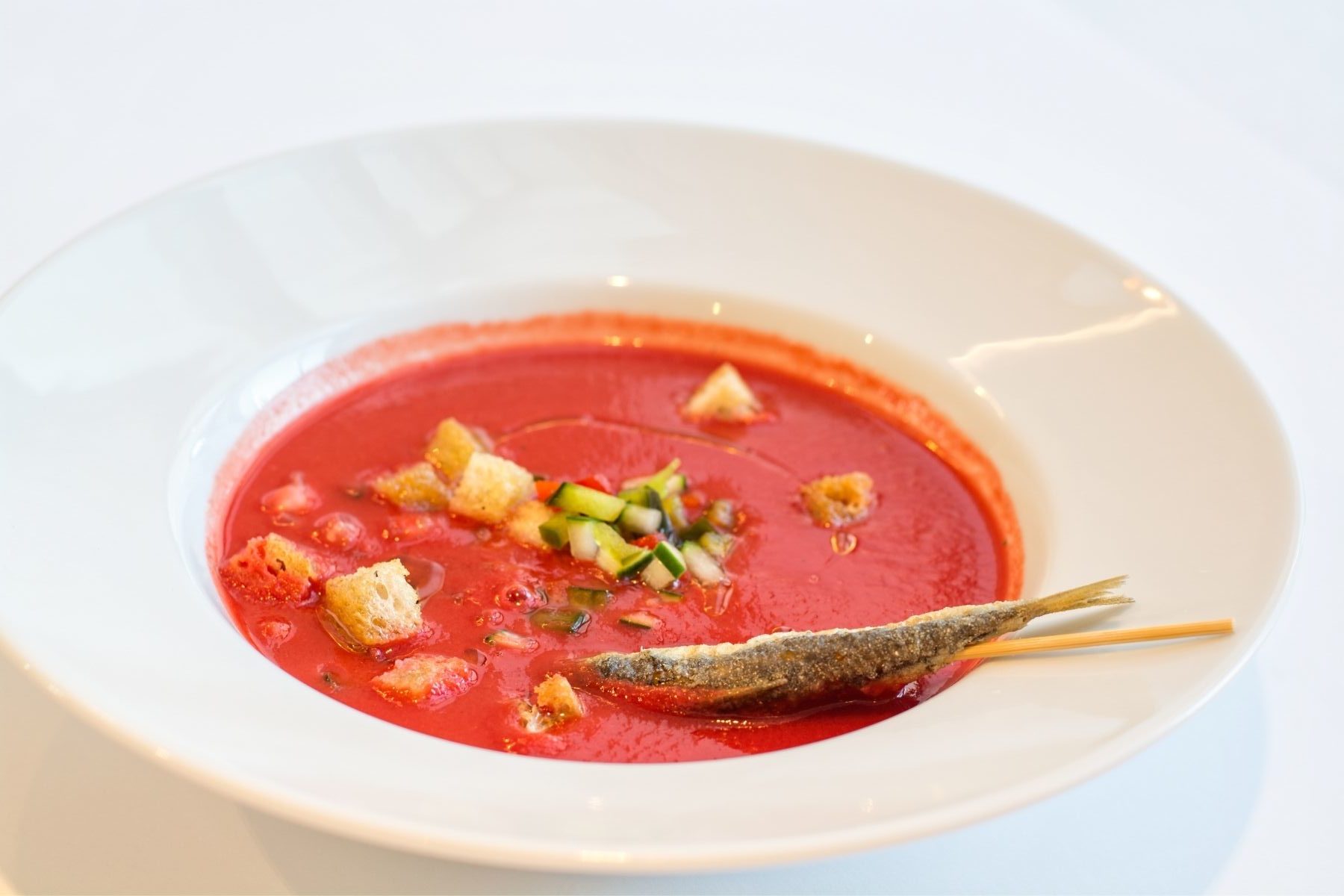
Gaspacho soup with tomato and watermelon
1.5 kg tomato What does this mean?
500 g watermelon pulp
½ red pepper
2 garlic cloves
2 c. olive oil soup
2 c. white wine vinegar
1 c. salt dessert
ice
Basil leaves
ground pepper
Method:
- Take the skin off the watermelon, clean out the seeds and cut it into cubes.
- Skin the tomato, clean out the seeds and cut it into small pieces.
- Skin the cucumber, cut ¼ into thin slices and set aside. Clean the rest of the seeds and chop it into pieces.
- Reserve ¼ of the watermelon and put the rest in a blender. Add the tomato and cucumber cubes, 5 basil leaves and season with salt and lime juice.
- Blend everything very well and take it to the fridge to cool.
- Serve the gazpacho garnished with reserved watermelon cubes and cucumber slices and sprinkle with pepper and basil leaves.
Enjoy !

